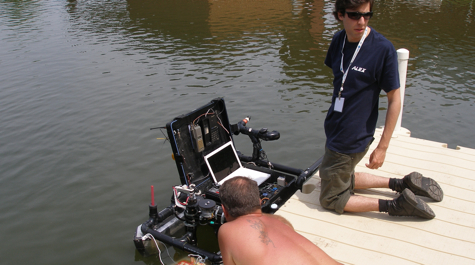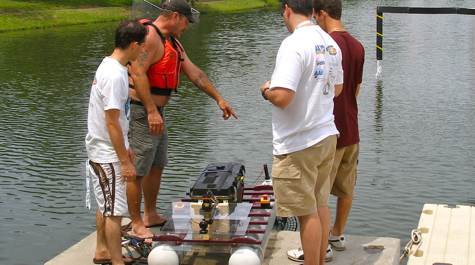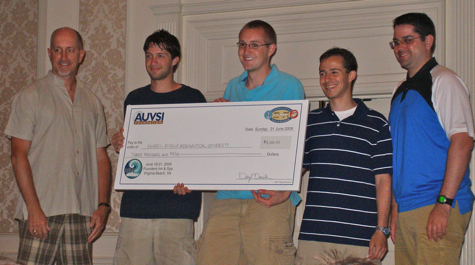VIMS assists in International RoboBoat Competition
Professor Mark Patterson of the Virginia Institute of Marine Science will manage logistics for the 4th International RoboBoat Competition, which will take place June 9 - 12 at the Founders Inn in Virginia Beach (get directions). The competition is jointly sponsored by the Association of Unmanned Vehicle Systems International Foundation and the Office of Naval Research.
It will be the third straight year that Patterson, head of the Autonomous Systems Laboratory at VIMS, will assist in the event, a robotics challenge in which teams of undergraduate students from universities around the world race robotic boats of their own design through an aquatic obstacle course.
Patterson says "Observers gain a new appreciation for what may appear as relatively easy tasks when they learn that the boats must complete the course without any human guidance or intervention."
Patterson, a marine biologist with patents in autonomous underwater vehicle (AUV) technology, is winner of the Marine Technology Society's 2008 Lockheed Martin Award for Ocean Science and Engineering. Assisting him in the competition will be graduate student Jennifer Elliott from the School of Marine Science at VIMS and William and Mary undergraduates Sara Williams and David Godschalk.
During this year’s event, 150 students from 16 universities in the U.S., Canada, Taiwan, and Indonesia will compete for the title of “Best RoboBoat” and $20,000 in prize money. Their robotic boats will be asked to perform a series of progressively more difficult tasks that simulate the types of activities that are expected of robotic craft built for the U.S. Navy and Coast Guard.
Patterson says this year’s course will prove particularly challenging. “The course will be a harder because the technology and the teams are better,” says Patterson. “They try to add some new twists every year.”
Because of the large number of teams, this year’s event will feature two side-by-side courses to allow for simultaneous races. Past events had a single course with one team competing at a time.
Patterson says the two mirror-image courses may provide for some interesting wrinkles in this year’s competition. “What happens if the robot on Course A gets onto course B and tries to start navigating that course instead?” he asks with a chuckle.
The new set-up should help keep Elliott, Williams, and Godschalk busy. Their job during the competition, using the decidedly old-fashioned technology of kayaks, is to chase down any of the high-tech robots that go astray. They are also involved in setting up the course before competition begins.
Competitors in the 2011 event are Cedarville University (Ohio); Diponegoro University, (Indonesia); Embry Riddle; Florida Atlantic University; Georgia Tech, Atlanta (Aerospace Systems Design Lab); Georgia Tech (Savannah Robotics); National Cheng Kung University (Taiwan); Old Dominion University; Stevens Institute of Technology; United States Naval Academy; University of Central Florida; University of Michigan; University of Ottawa; University of Rhode Island; Villanova University; and Virginia Tech.
Last year’s first prize went to the University of Michigan. The University of Central Florida, the University of Rhode Island, Virginia Tech, and the U.S. Naval Academy rounded out last year’s top five places.
Patterson's Autonomous Systems Laboratory at VIMS aims to advance marine science by creating the next generation of autonomous underwater vehicles (AUVs) and by developing methods for using them to explore the world's oceans. AUVs developed in the VIMS lab have explored Antarctica, Bonaire, Chesapeake Bay, the Florida Keys, California, the Gulf of Mexico, and Iceland.
Based in Washington, DC, the AUVSI Foundation is an education-oriented charity that organizes and sponsors 7 annual robotic-related student competitions. The Foundation supports the goals and objectives of the Association for Unmanned Vehicle Systems International (AUVSI), the world's largest and oldest trade association devoted to advancing the use of unmanned systems.
VIMS, one of the largest marine centers in the U.S., provides research, education, and advisory service to help protect and restore Chesapeake Bay and coastal waters. The Institute offers Master's and Ph.D. degrees through its School of Marine Science, part of the College of William and Mary
For more information on the Competition, including a schedule and links to the team websites, visit www.roboboats.org.





